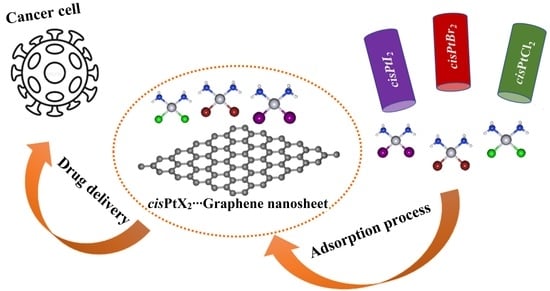On the Use of Graphene Nanosheets for Drug Delivery: A Case Study of Cisplatin and Some of Its Analogs
Abstract
:1. Introduction
2. Computational Methods
3. Results and Discussion
3.1. Geometric Structures
3.2. Adsorption Energy Calculations
3.3. Frontier Molecular Orbital (FMO) Calculations
3.4. Charge Transfer Calculations
3.5. Band Structure Calculations
3.6. Density of States (DOS) Calculations
3.7. Recovery Time
3.8. Solvent Effects
4. Conclusions
Supplementary Materials
Author Contributions
Funding
Data Availability Statement
Acknowledgments
Conflicts of Interest
References
- Rani, P.; Jindal, V.K. Designing band gap of graphene by B and N dopant atoms. RSC Adv. 2013, 3, 802–812. [Google Scholar] [CrossRef]
- Mohammed, M.H. Designing and engineering electronic band gap of graphene nanosheet by P dopants. Solid State Commun. 2017, 258, 11–16. [Google Scholar] [CrossRef]
- Geim, A.K.; Novoselov, K.S. The rise of graphene. Nat. Mater. 2007, 6, 183–191. [Google Scholar] [CrossRef] [PubMed]
- Zhang, J.; Zhao, F.; Zhang, Z.; Chen, N.; Qu, L. Dimension-tailored functional graphene structures for energy conversion and storage. Nanoscale 2013, 5, 3112–3126. [Google Scholar] [CrossRef]
- Sun, Y.Q.; Wu, Q.O.; Shi, G.Q. Graphene based new energy materials. Energy Environ. Sci. 2011, 4, 1113–1132. [Google Scholar] [CrossRef]
- Mahmood, N.; Zhang, C.Z.; Yin, H.; Hou, Y.L. Graphene-based nanocomposites for energy storage and conversion in lithium batteries, supercapacitors and fuel cells. J. Mater. Chem. A 2014, 2, 15–32. [Google Scholar] [CrossRef]
- Ibrahim, M.A.A.; Mahmoud, A.H.M.; Soliman, K.A.; Mekhemer, G.A.H.; Ahmed, M.N.; Shawky, A.M.; Abourehab, M.A.S.; Elkaeed, E.B.; Soliman, M.E.S.; Moussa, N.A.M. Borophene and Pristine Graphene 2D Sheets as Potential Surfaces for the Adsorption of Electron-Rich and Electron-Deficient pi-Systems: A Comparative DFT Study. Nanomaterials 2022, 12, 1028. [Google Scholar] [CrossRef]
- Ibrahim, M.A.A.; Mahmoud, A.H.M.; Mekhemer, G.A.H.; Shawky, A.M.; Soliman, M.E.S.; Moussa, N.A.M. Adsorption Behavior of Toxic Carbon Dichalcogenides (CX2; X = O, S, or Se) on β12 Borophene and Pristine Graphene Sheets: A DFT Study. Nanomaterials 2022, 12, 3411. [Google Scholar] [CrossRef]
- Mollaamin, F.; Monajjemi, M. Doping of Graphene Nanostructure with Iron, Nickel and Zinc as Selective Detector for the Toxic Gas Removal: A Density Functional Theory Study. C 2023, 9, 20. [Google Scholar] [CrossRef]
- Xie, T.; Wang, P.; Tian, C.; Zhao, G.; Jia, J.; He, C.; Zhao, C.; Wu, H. Adsorption Characteristics of Gas Molecules Adsorbed on Graphene Doped with Mn: A First Principle Study. Molecules 2022, 27, 2315. [Google Scholar] [CrossRef]
- Jayaprakash, G.K. Pre-post redox electron transfer regioselectivity at the alanine modified nano graphene electrode interface. Chem. Phys. Lett. 2022, 789, 139295. [Google Scholar] [CrossRef]
- Shahabi, M.; Raissi, H. Investigation of the solvent effect, molecular structure, electronic properties and adsorption mechanism of Tegafur anticancer drug on Graphene nanosheet surface as drug delivery system by molecular dynamics simulation and density functional approach. J. Incl. Phenom. Macrocycl. Chem. 2017, 88, 159–169. [Google Scholar] [CrossRef]
- Hoseini-Ghahfarokhi, M.; Mirkiani, S.; Mozaffari, N.; Abdolahi Sadatlu, M.A.; Ghasemi, A.; Abbaspour, S.; Akbarian, M.; Farjadian, F.; Karimi, M. Applications of Graphene and Graphene Oxide in Smart Drug/Gene Delivery: Is the World Still Flat? Int. J. Nanomed. 2020, 15, 9469–9496. [Google Scholar] [CrossRef]
- Liu, Z.; Robinson, J.T.; Sun, X.; Dai, H. PEGylated nanographene oxide for delivery of water-insoluble cancer drugs. J. Am. Chem. Soc. 2008, 130, 10876–10877. [Google Scholar] [CrossRef]
- Sun, X.; Liu, Z.; Welsher, K.; Robinson, J.T.; Goodwin, A.; Zaric, S.; Dai, H. Nano-Graphene Oxide for Cellular Imaging and Drug Delivery. Nano Res. 2008, 1, 203–212. [Google Scholar] [CrossRef]
- Jiang, J.H.; Pi, J.; Jin, H.; Cai, J.Y. Functional graphene oxide as cancer-targeted drug delivery system to selectively induce oesophageal cancer cell apoptosis. Artif. Cells Nanomed. Biotechnol. 2018, 46, S297–S307. [Google Scholar] [CrossRef]
- Kumari, S.; Nehra, A.; Gupta, K.; Puri, A.; Kumar, V.; Singh, K.P.; Kumar, M.; Sharma, A. Chlorambucil-Loaded Graphene-Oxide-Based Nano-Vesicles for Cancer Therapy. Pharmaceutics 2023, 15, 649. [Google Scholar] [CrossRef]
- Rahimi, S.; van Leeuwen, D.; Roshanzamir, F.; Pandit, S.; Shi, L.; Sasanian, N.; Nielsen, J.; Esbjörner, E.K.; Mijakovic, I. Ginsenoside Rg3 Reduces the Toxicity of Graphene Oxide Used for pH-Responsive Delivery of Doxorubicin to Liver and Breast Cancer Cells. Pharmaceutics 2023, 15, 391. [Google Scholar] [CrossRef]
- Mohammadi Tabar, M.; Khaleghi, M.; Bidram, E.; Zarepour, A.; Zarrabi, A. Penicillin and Oxacillin Loaded on PEGylated-Graphene Oxide to Enhance the Activity of the Antibiotics against Methicillin-Resistant Staphylococcus aureus. Pharmaceutics 2022, 14, 2049. [Google Scholar] [CrossRef]
- Khodadadi, Z.; Torkian, L. Studying metal-doped graphene nanosheet as a drug carrier for anticancer drug β-lapachone using Density Functional Theory (DFT). Mater. Res. Express 2019, 6, 065058. [Google Scholar] [CrossRef]
- Mohammed, M.H.; Hanoon, F.H. Theoretical prediction of delivery and adsorption of various anticancer drugs into pristine and metal-doped graphene nanosheet. Chin. J. Phys. 2020, 68, 578–595. [Google Scholar] [CrossRef]
- Dastani, N.; Arab, A.; Raissi, H. DFT computational study towards investigating Cladribine anticancer drug adsorption on the graphene and functionalized graphene. Struct. Chem. 2020, 31, 1691–1705. [Google Scholar] [CrossRef]
- Frezza, M.; Hindo, S.; Chen, D.; Davenport, A.; Schmitt, S.; Tomco, D.; Dou, Q.P. Novel metals and metal complexes as platforms for cancer therapy. Curr. Pharm. Des. 2010, 16, 1813–1825. [Google Scholar] [CrossRef] [PubMed]
- Onsori, S.; Alipour, E. A computational study on the cisplatin drug interaction with boron nitride nanocluster. J. Mol. Graph. Model. 2018, 79, 223–229. [Google Scholar] [CrossRef]
- Dasari, S.; Tchounwou, P.B. Cisplatin in cancer therapy: Molecular mechanisms of action. Eur. J. Pharmacol. 2014, 740, 364–378. [Google Scholar] [CrossRef]
- Johnstone, T.C.; Suntharalingam, K.; Lippard, S.J. The Next Generation of Platinum Drugs: Targeted Pt(II) Agents, Nanoparticle Delivery, and Pt(IV) Prodrugs. Chem. Rev. 2016, 116, 3436–3486. [Google Scholar] [CrossRef]
- Wang, X.; Guo, Z. Targeting and delivery of platinum-based anticancer drugs. Chem. Soc. Rev. 2013, 42, 202–224. [Google Scholar] [CrossRef]
- Wang, J.; Wu, G.S. Role of autophagy in cisplatin resistance in ovarian cancer cells. J. Biol. Chem. 2014, 289, 17163–17173. [Google Scholar] [CrossRef]
- Florea, A.M.; Busselberg, D. Cisplatin as an anti-tumor drug: Cellular mechanisms of activity, drug resistance and induced side effects. Cancers 2011, 3, 1351–1371. [Google Scholar] [CrossRef]
- Rixe, O.; Ortuzar, W.; Alvarez, M.; Parker, R.; Reed, E.; Paull, K.; Fojo, T. Oxaliplatin, tetraplatin, cisplatin, and carboplatin: Spectrum of activity in drug-resistant cell lines and in the cell lines of the National Cancer Institute’s Anticancer Drug Screen panel. Biochem. Pharmacol. 1996, 52, 1855–1865. [Google Scholar] [CrossRef]
- Marzo, T.; Pillozzi, S.; Hrabina, O.; Kasparkova, J.; Brabec, V.; Arcangeli, A.; Bartoli, G.; Severi, M.; Lunghi, A.; Totti, F.; et al. cis-Pt I2(NH3)2: A reappraisal. Dalton Trans. 2015, 44, 14896–14905. [Google Scholar] [CrossRef]
- Marzo, T.; Bartoli, G.; Gabbiani, C.; Pescitelli, G.; Severi, M.; Pillozzi, S.; Michelucci, E.; Fiorini, B.; Arcangeli, A.; Quiroga, A.G.; et al. Cisplatin and its dibromido analogue: A comparison of chemical and biological profiles. Biometals 2016, 29, 535–542. [Google Scholar] [CrossRef]
- Oun, R.; Moussa, Y.E.; Wheate, N.J. The side effects of platinum-based chemotherapy drugs: A review for chemists. Dalton Trans. 2018, 47, 6645–6653. [Google Scholar] [CrossRef]
- Rabik, C.A.; Dolan, M.E. Molecular mechanisms of resistance and toxicity associated with platinating agents. Cancer Treat. Rev. 2007, 33, 9–23. [Google Scholar] [CrossRef]
- Xian, C.; Chen, H.; Xiong, F.; Fang, Y.; Huang, H.; Wu, J. Platinum-based chemotherapy via nanocarriers and co-delivery of multiple drugs. Biomater. Sci. 2021, 9, 6023–6036. [Google Scholar] [CrossRef]
- Zhang, Q.; Kuang, G.; Zhang, L.; Zhu, Y. Nanocarriers for platinum drug delivery. Biomed. Technol. 2023, 2, 77–89. [Google Scholar] [CrossRef]
- Cuevas-Flores, M.D.R.; Garcia-Revilla, M.A.; Bartolomei, M. Noncovalent interactions between cisplatin and graphene prototypes. J. Comput. Chem. 2018, 39, 71–80. [Google Scholar] [CrossRef]
- Cuevas-Flores, M.D.R.; Bartolomei, M.; Garcia-Revilla, M.A.; Coletti, C. Interaction and Reactivity of Cisplatin Physisorbed on Graphene Oxide Nano-Prototypes. Nanomaterials 2020, 10, 1074. [Google Scholar] [CrossRef]
- Tian, L.Y.; Pei, X.B.; Zeng, Y.X.; He, R.; Li, Z.J.; Wang, J.; Wan, Q.B.; Li, X.Y. Functionalized nanoscale graphene oxide for high efficient drug delivery of cisplatin. J. Nanopart. Res. 2014, 16, 2709. [Google Scholar] [CrossRef]
- Cheng, S.J.; Chiu, H.Y.; Kumar, P.V.; Hsieh, K.Y.; Yang, J.W.; Lin, Y.R.; Shen, Y.C.; Chen, G.Y. Simultaneous drug delivery and cellular imaging using graphene oxide. Biomater. Sci. 2018, 6, 813–819. [Google Scholar] [CrossRef]
- Kresse, G.; Furthmuller, J. Efficient iterative schemes for ab initio total-energy calculations using a plane-wave basis set. Phys. Rev. B 1996, 54, 11169–11186. [Google Scholar] [CrossRef]
- Kresse, G.; Furthmuller, J. Efficiency of ab-initio total energy calculations for metals and semiconductors using a plane-wave basis set. Comp. Mater. Sci. 1996, 6, 15–50. [Google Scholar] [CrossRef]
- Giannozzi, P.; Baroni, S.; Bonini, N.; Calandra, M.; Car, R.; Cavazzoni, C.; Ceresoli, D.; Chiarotti, G.L.; Cococcioni, M.; Dabo, I.; et al. QUANTUM ESPRESSO: A modular and open-source software project for quantum simulations of materials. J. Phys. Condens. Matter 2009, 21, 395502. [Google Scholar] [CrossRef] [PubMed]
- Giannozzi, P.; Andreussi, O.; Brumme, T.; Bunau, O.; Buongiorno Nardelli, M.; Calandra, M.; Car, R.; Cavazzoni, C.; Ceresoli, D.; Cococcioni, M.; et al. Advanced capabilities for materials modelling with Quantum ESPRESSO. J. Phys. Condens. Matter 2017, 29, 465901. [Google Scholar] [CrossRef] [PubMed]
- Perdew, J.P.; Burke, K.; Ernzerhof, M. Generalized gradient approximation made simple. Phys. Rev. Lett. 1996, 77, 3865–3868. [Google Scholar] [CrossRef] [PubMed]
- Vanderbilt, D. Soft self-consistent pseudopotentials in a generalized eigenvalue formalism. Phys. Rev. B 1990, 41, 7892–7895. [Google Scholar] [CrossRef]
- Grimme, S. Semiempirical GGA-type density functional constructed with a long-range dispersion correction. J. Comput. Chem. 2006, 27, 1787–1799. [Google Scholar] [CrossRef]
- Marzari, N.; Vanderbilt, D.; De Vita, A.; Payne, M.C. Thermal contraction and disordering of the Al(110) surface. Phys. Rev. Lett. 1999, 82, 3296–3299. [Google Scholar] [CrossRef]
- Henkelman, G.; Arnaldsson, A.; Jonsson, H. A fast and robust algorithm for Bader decomposition of charge density. Comp. Mater. Sci. 2006, 36, 354–360. [Google Scholar] [CrossRef]
- Kutzelnigg, W. Book Review: Atoms in Molecules. A Quantum Theory. (International Series Monographs on Chemistry, Vol. 22). By R. F. W. Bader. Angew. Chem. Int. Ed. Engl. 1993, 32, 128–129. [Google Scholar] [CrossRef]
- Momma, K.; Izumi, F. VESTA 3 for three-dimensional visualization of crystal, volumetric and morphology data. J. Appl. Crystallogr. 2011, 44, 1272–1276. [Google Scholar] [CrossRef]
- Andreussi, O.; Dabo, I.; Marzari, N. Revised self-consistent continuum solvation in electronic-structure calculations. J. Chem. Phys. 2012, 136, 064102. [Google Scholar] [CrossRef]
- Wang, K.D.; He, X.; Rong, C.Y.; Zhong, A.G.; Liu, S.B.; Zhao, D.B. On the origin and nature of internal methyl rotation barriers: An information-theoretic approach study. Theor. Chem. Acc. 2022, 141, 68. [Google Scholar] [CrossRef]
- Cao, X.; Rong, C.; Zhong, A.; Lu, T.; Liu, S. Molecular acidity: An accurate description with information-theoretic approach in density functional reactivity theory. J. Comput. Chem. 2018, 39, 117–129. [Google Scholar] [CrossRef]
- Ai-Guo, Z. Dissecting the nature of halogen bonding interactions from energy decomposition and wavefunction analysis. Mon. Für Chem.-Chem. Mon. 2017, 148, 1259–1267. [Google Scholar] [CrossRef]
- Chen, J.; Zhang, Z.; Ma, J.; Nezamzadeh-Ejhieh, A.; Lu, C.; Pan, Y.; Liu, J.; Bai, Z. Current status and prospects of MOFs in controlled delivery of Pt anticancer drugs. Dalton Trans. 2023, 52, 6226–6238. [Google Scholar] [CrossRef]
- Ito, J.; Nakamura, J.; Natori, A. Semiconducting nature of the oxygen-adsorbed graphene sheet. J. Appl. Phys. 2008, 103, 113712. [Google Scholar] [CrossRef]
- Yin, M.T.; Cohen, M.L. Structural Theory of Graphite and Graphitic Silicon. Phys. Rev. B 1984, 29, 6996–6998. [Google Scholar] [CrossRef]
- Schabel, M.C.; Martins, J.L. Energetics of interplanar binding in graphite. Phys. Rev. B 1992, 46, 7185–7188. [Google Scholar] [CrossRef]
- Paufler, P.D. McKie and C. McKie. Essentials of Crystallography. Blackwell Scientific Publications, Oxford 1992. 437 p., pbk. L 19.50. ISBN 0-632-01574-8. Cryst. Res. Technol. 1993, 28, 812. [Google Scholar] [CrossRef]
- Pozzo, M.; Alfe, D.; Lacovig, P.; Hofmann, P.; Lizzit, S.; Baraldi, A. Thermal expansion of supported and freestanding graphene: Lattice constant versus interatomic distance. Phys. Rev. Lett. 2011, 106, 135501. [Google Scholar] [CrossRef] [PubMed]
- Bader, R.F.W.; Nguyen-Dang, T.T. Quantum Theory of Atoms in Molecules–Dalton Revisited. In Advances in Quantum Chemistry; Löwdin, P.-O., Ed.; Academic Press: Cambridge, MA, USA, 1981; Volume 14, pp. 63–124. [Google Scholar]
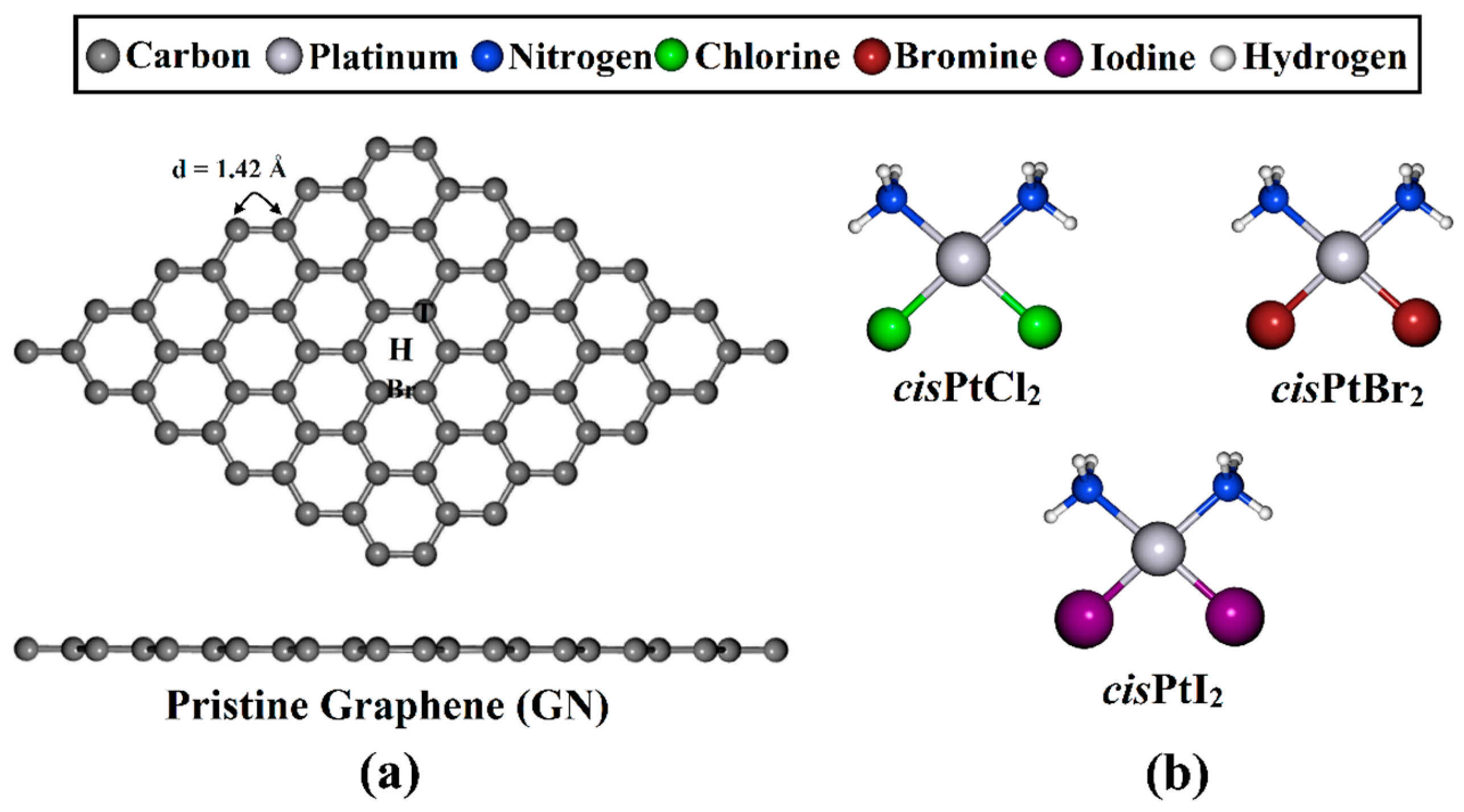

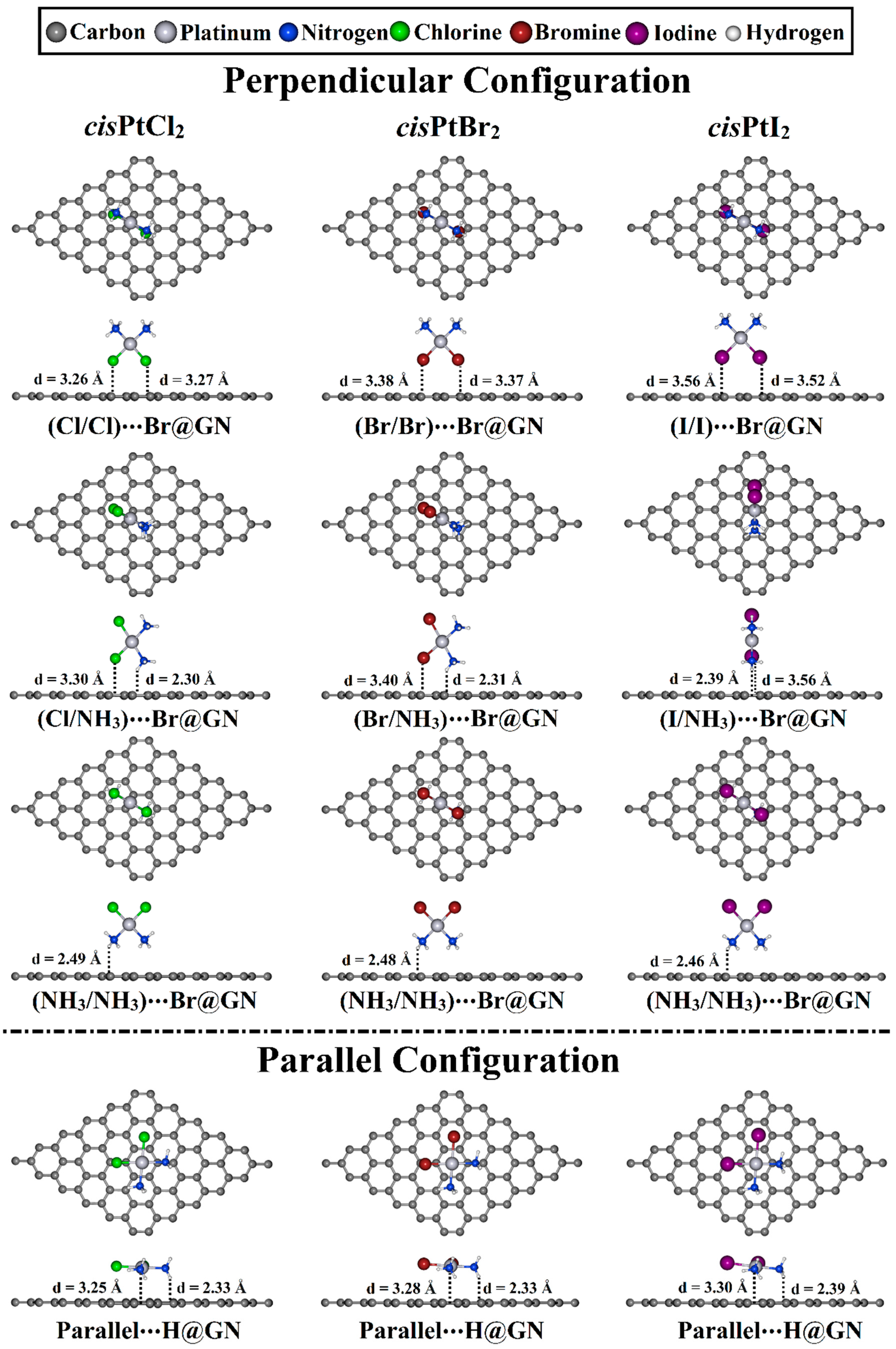
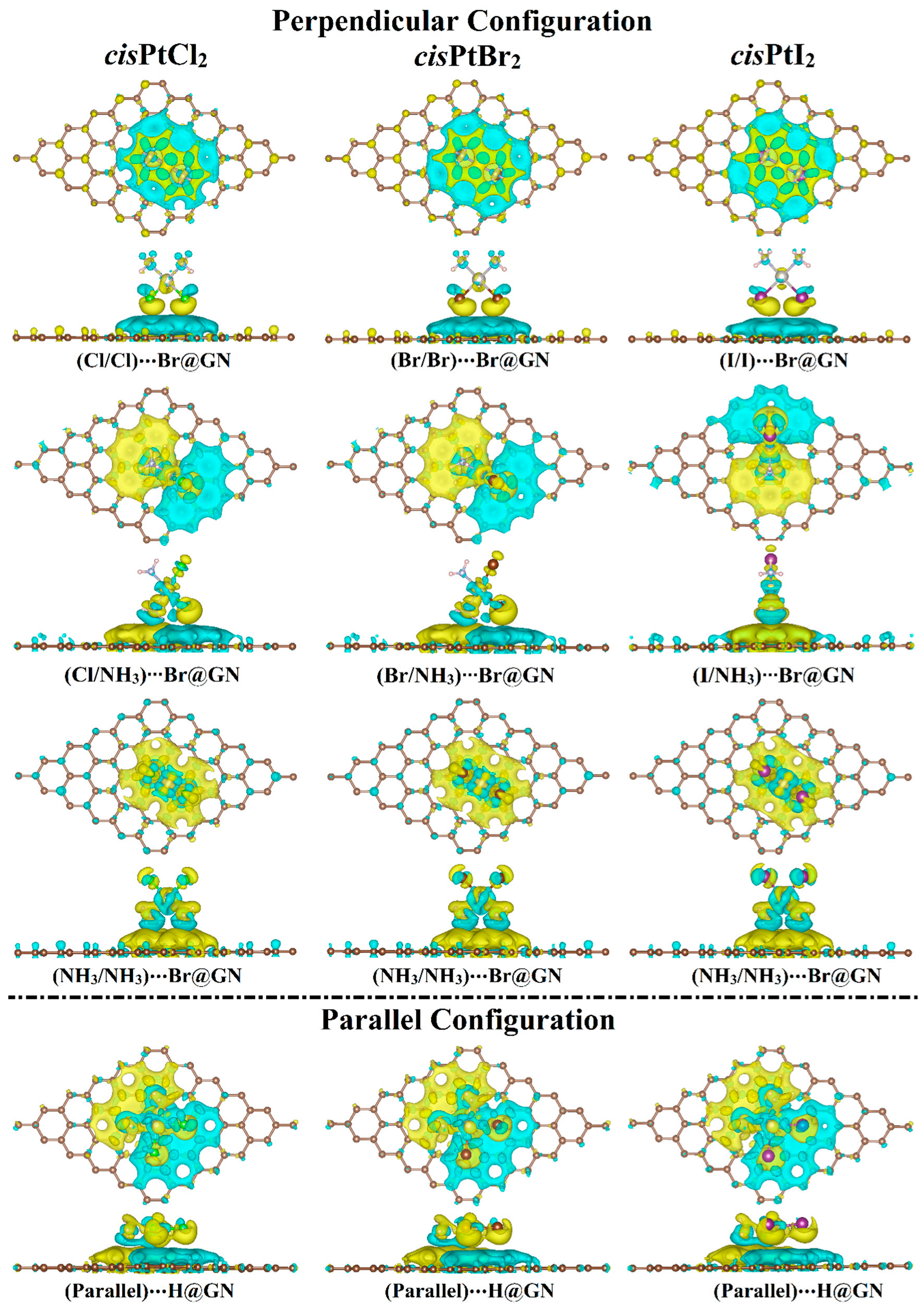

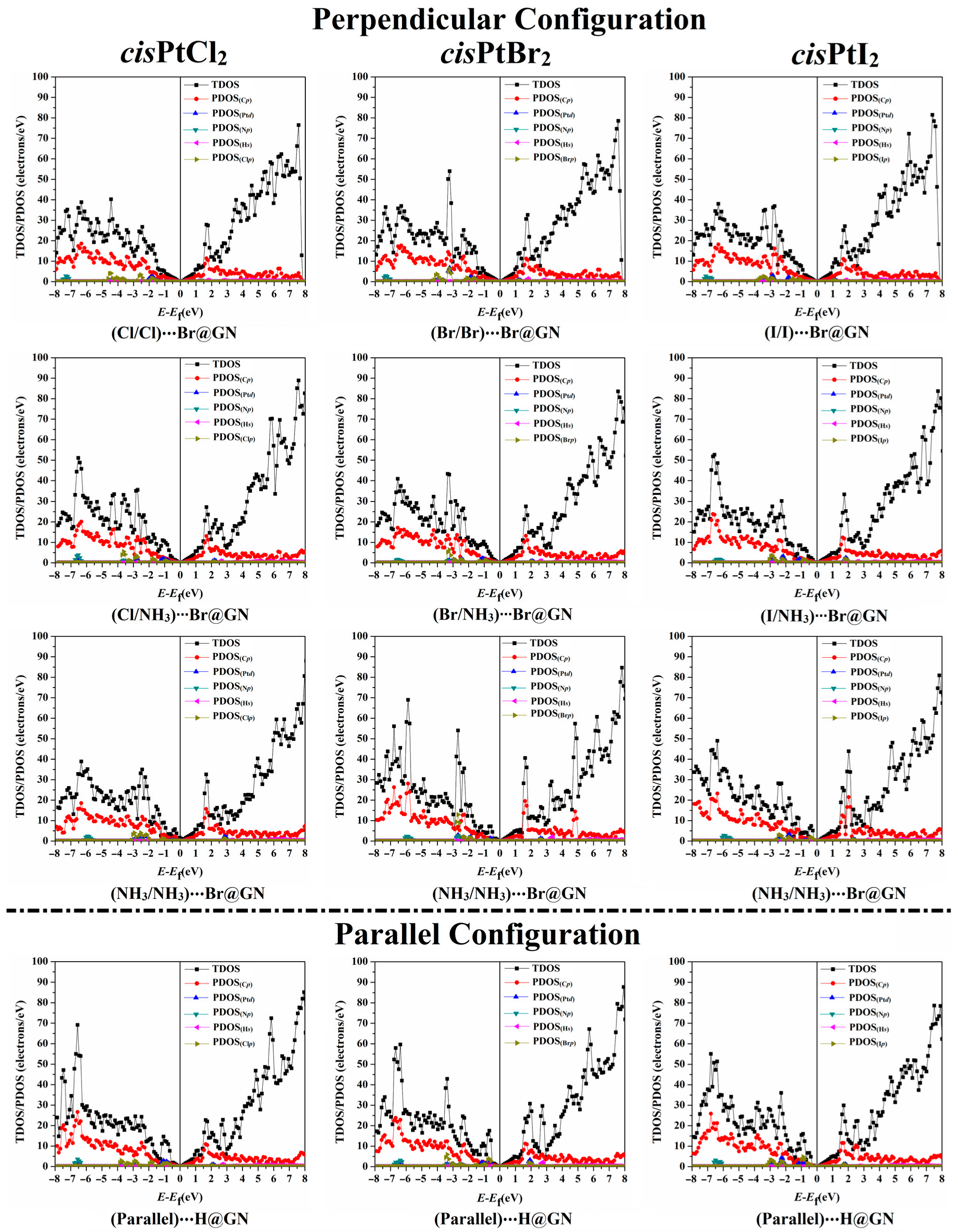
| Orientation a | Adsorption Site b | cisPtCl2 | cisPtBr2 | cisPtI2 | |||
|---|---|---|---|---|---|---|---|
| Eads (kcal/mol) | Qt c (e) | Eads (kcal/mol) | Qt c (e) | Eads (kcal/mol) | Qt c (e) | ||
| Perpendicular Configuration | |||||||
| X/X⋯GN | T | −8.13 | 0.0165 | −9.19 | 0.0244 | −10.69 | 0.0369 |
| Br | −8.32 | 0.0179 | −9.38 | 0.0252 | −10.83 | 0.0375 | |
| H | −7.93 | 0.0147 | −9.10 | 0.0239 | −10.68 | 0.0385 | |
| X/NH3⋯GN | T | −9.70 | −0.0051 | −10.15 | 0.0001 | −10.99 | 0.0102 |
| Br | −9.89 | −0.0056 | −10.60 | 0.0008 | −11.14 | 0.0124 | |
| H | −9.33 | −0.0054 | −9.85 | 0.0003 | −11.12 | 0.0090 | |
| NH3/NH3⋯GN | T | −12.60 | −0.0189 | −12.73 | −0.0105 | −13.09 | 0.0221 |
| Br | −12.73 | −0.0159 | −13.01 | −0.0028 | −13.36 | 0.0250 | |
| H | −12.27 | −0.0215 | −12.39 | −0.0091 | −12.84 | 0.0234 | |
| Parallel Configuration | |||||||
| Parallel⋯GN | T | −22.56 | −0.0008 | −23.98 | 0.0147 | −25.24 | 0.0298 |
| Br | −22.67 | 0.0014 | −24.03 | 0.0125 | −25.61 | 0.0310 | |
| H | −22.76 | 0.0042 | −24.07 | 0.0156 | −25.67 | 0.0312 | |
| System | EHOMO (eV) | ELUMO (eV) | Egap (eV) |
|---|---|---|---|
| GN Nanosheet | −2.355 | −2.339 | 0.016 |
| cisPtCl2 | −4.824 | −1.992 | 2.831 |
| cisPtBr2 | −4.720 | −2.161 | 2.559 |
| cisPtI2 | −4.547 | −2.313 | 2.235 |
| Orientation a | System b | EHOMO (eV) | ELUMO (eV) | Egap (eV) |
|---|---|---|---|---|
| Perpendicular Configuration | ||||
| X/X⋯Br@GN | cisPtCl2 | −1.566 | −1.557 | 0.009 |
| cisPtBr2 | −1.571 | −1.562 | 0.009 | |
| cisPtI2 | −1.571 | −1.561 | 0.009 | |
| X/NH3⋯Br@GN | cisPtCl2 | −2.173 | −2.158 | 0.015 |
| cisPtBr2 | −2.173 | −2.159 | 0.015 | |
| cisPtI2 | −2.141 | −2.128 | 0.014 | |
| NH3/NH3⋯Br@GN | cisPtCl2 | −2.672 | −2.657 | 0.015 |
| cisPtBr2 | −2.626 | −2.612 | 0.015 | |
| cisPtI2 | −2.528 | −2.523 | 0.005 | |
| Parallel Configuration | ||||
| Parallel⋯H@GN | cisPtCl2 | −2.155 | −2.129 | 0.025 |
| cisPtBr2 | −2.143 | −2.118 | 0.025 | |
| cisPtI2 | −2.127 | −2.101 | 0.026 | |
| Orientation a | cisPtX2⋯GN Complexes | Recovery Time (ms) | ||
|---|---|---|---|---|
| T (298.15 K) | T (310.15 K) | T (315.15 K) | ||
| Perpendicular Configuration | ||||
| X/X | cisPtCl2⋯Br@GN | 12.30 × 10−4 | 7.15 × 10−4 | 5.77 × 10−4 |
| cisPtBr2⋯Br@GN | 7.34 × 10−3 | 3.90 × 10−3 | 3.13 × 10−3 | |
| cisPtI2⋯Br@GN | 8.45 × 10−2 | 4.17 × 10−2 | 3.16 × 10−2 | |
| X/NH3 | cisPtCl2⋯Br@GN | 17.34 × 10−3 | 9.10 × 10−3 | 7.05 × 10−3 |
| cisPtBr2⋯Br@GN | 5.74 × 10−2 | 2.80 × 10−2 | 2.19 × 10−2 | |
| cisPtI2⋯Br@GN | 14.26 × 10−2 | 6.90 × 10−2 | 5.18 × 10−2 | |
| NH3/NH3 | cisPtCl2⋯Br@GN | 2.08 | 0.90 | 0.65 |
| cisPtBr2⋯Br@GN | 3.33 | 1.42 | 1.02 | |
| cisPtI2⋯Br@GN | 6.01 | 2.52 | 1.79 | |
| Parallel Configuration | ||||
| Parallel | cisPtCl2⋯H@GN | 45.68 × 106 | 10.36 × 106 | 5.77 × 106 |
| cisPtBr2⋯H@GN | 41.56 × 107 | 8.65 × 107 | 4.66 × 107 | |
| cisPtI2⋯H@GN | 61.63 × 108 | 11.56 × 108 | 5.97 × 108 | |
| Orientation a | cisPtX2⋯GN Complexes | (kcal/mol) | (kcal/mol) |
|---|---|---|---|
| Perpendicular Configuration | |||
| X/X | cisPtCl2⋯Br@GN | −8.10 | 0.2240 |
| cisPtBr2⋯Br@GN | −10.14 | −0.7594 | |
| cisPtI2⋯Br@GN | −12.92 | −2.0973 | |
| X/NH3 | cisPtCl2⋯Br@GN | −9.24 | 0.6490 |
| cisPtBr2⋯Br@GN | −10.40 | 0.2039 | |
| cisPtI2⋯Br@GN | −11.57 | −0.4303 | |
| NH3/NH3 | cisPtCl2⋯Br@GN | −8.94 | 3.7919 |
| cisPtBr2⋯Br@GN | −9.02 | 3.9848 | |
| cisPtI2⋯Br@GN | −9.14 | 4.0657 | |
| Parallel Configuration | |||
| Parallel | cisPtCl2⋯H@GN | −18.21 | 4.5553 |
| cisPtBr2⋯H@GN | −20.02 | 4.0526 | |
| cisPtI2⋯H@GN | −22.40 | 3.2723 | |
Disclaimer/Publisher’s Note: The statements, opinions and data contained in all publications are solely those of the individual author(s) and contributor(s) and not of MDPI and/or the editor(s). MDPI and/or the editor(s) disclaim responsibility for any injury to people or property resulting from any ideas, methods, instructions or products referred to in the content. |
© 2023 by the authors. Licensee MDPI, Basel, Switzerland. This article is an open access article distributed under the terms and conditions of the Creative Commons Attribution (CC BY) license (https://creativecommons.org/licenses/by/4.0/).
Share and Cite
Ibrahim, M.A.A.; Hamad, M.H.A.; Mahmoud, A.H.M.; Mekhemer, G.A.H.; Sayed, S.R.M.; El-Rahman, M.K.A.; Sidhom, P.A.; Dabbish, E.; Shoeib, T. On the Use of Graphene Nanosheets for Drug Delivery: A Case Study of Cisplatin and Some of Its Analogs. Pharmaceutics 2023, 15, 1640. https://doi.org/10.3390/pharmaceutics15061640
Ibrahim MAA, Hamad MHA, Mahmoud AHM, Mekhemer GAH, Sayed SRM, El-Rahman MKA, Sidhom PA, Dabbish E, Shoeib T. On the Use of Graphene Nanosheets for Drug Delivery: A Case Study of Cisplatin and Some of Its Analogs. Pharmaceutics. 2023; 15(6):1640. https://doi.org/10.3390/pharmaceutics15061640
Chicago/Turabian StyleIbrahim, Mahmoud A. A., Manar H. A. Hamad, Amna H. M. Mahmoud, Gamal A. H. Mekhemer, Shaban R. M. Sayed, Mohamed K. Abd El-Rahman, Peter A. Sidhom, Eslam Dabbish, and Tamer Shoeib. 2023. "On the Use of Graphene Nanosheets for Drug Delivery: A Case Study of Cisplatin and Some of Its Analogs" Pharmaceutics 15, no. 6: 1640. https://doi.org/10.3390/pharmaceutics15061640




